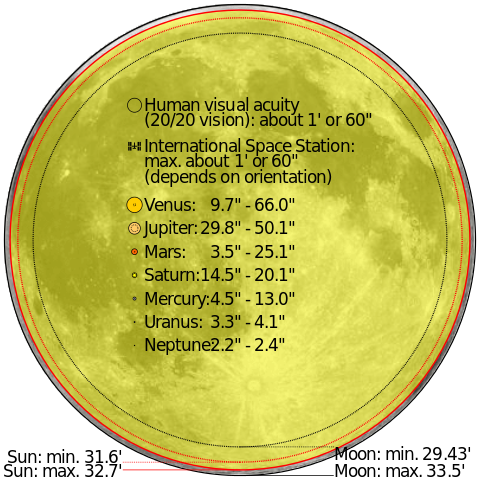
File:Comparison angular diameter.svg

| |
This is a file from the Wikimedia Commons. Information from its description page there is shown below.
Commons is a freely licensed media file repository. You can help. |
 |
This SVG image contains embedded raster graphics. Such images are liable to produce inferior results when scaled to different sizes. If appropriate to do so, they should be replaced with images created using vector graphics. |
Summary
Comparison of angular diameter of the Sun, Moon and planets with the International Space Station and human visual acuity. To get a true representation of the sizes, view the image at a distance of 102.6  times the width of the largest (Moon: max.) circle. For example, if this circle is 10 cm wide on your monitor, view it from 10.26 m away. Planetary angular diameters are from factsheets at http://nssdc.gsfc.nasa.gov/planetary/factsheet/ and Sun/Moon ones are from http://education.gsfc.nasa.gov/eclipse/pages/faq.html .
times the width of the largest (Moon: max.) circle. For example, if this circle is 10 cm wide on your monitor, view it from 10.26 m away. Planetary angular diameters are from factsheets at http://nssdc.gsfc.nasa.gov/planetary/factsheet/ and Sun/Moon ones are from http://education.gsfc.nasa.gov/eclipse/pages/faq.html .
| This is a retouched picture, which means that it has been digitally altered from its original version. Modifications: Make angular diameter comparison. The original can be viewed here: Full_Moon_as_Seen_From_Denmark.jpg. Modifications made by cmglee.
|
| |
This SVG file uses embedded text that can be easily translated into your language using this automated tool. Learn more. You can also download it and translate it manually using a text editor.
|
![]() ×The source code of this SVG is invalid.
×The source code of this SVG is invalid.
Licensing
|
File usage
Metadata
| Short title | Comparison of angular diameter of some celestial bodies |
|---|---|
| Image title | Comparison of angular diameter of the Sun, Moon and planets, compiled by CMG Lee. To get a true representation of the sizes, view the image at a distance of 103 [1 / tan(33.5/60 * pi/180)] times the width of the largest (Moon: max.) circle. For example, if this circle is 10 cm wide on your monitor, view it from 10.3 m away. Planetary angular diameters are from factsheets at http://nssdc.gsfc.nasa.gov/planetary/factsheet/ and Sun/Moon ones are from http://education.gsfc.nasa.gov/eclipse/pages/faq.html . Moon photograph is from http://commons.wikimedia.org/wiki/File:Full_Moon_as_Seen_From_Denmark.jpg . |
Schools Wikipedia facts
Schools Wikipedia was created by children's charity SOS Children. SOS Children helps more than 2 million people across 133 countries around the world. If you'd like to help, why not learn how to sponsor a child?

